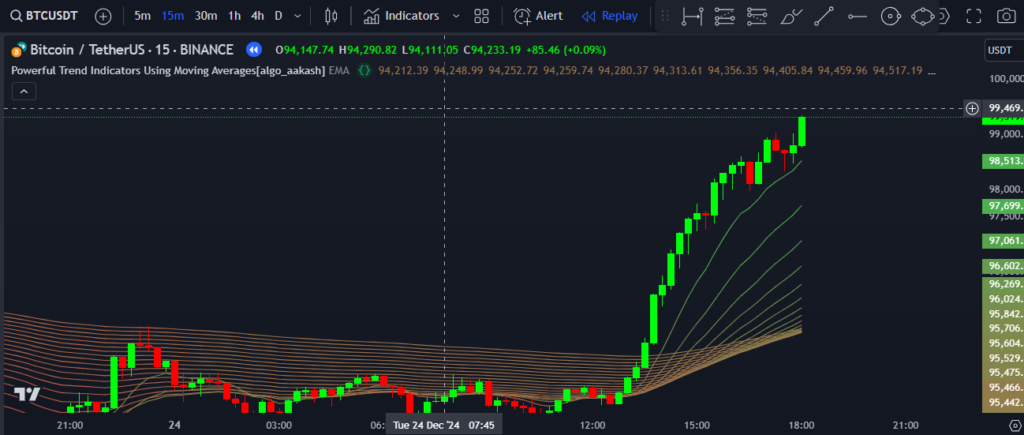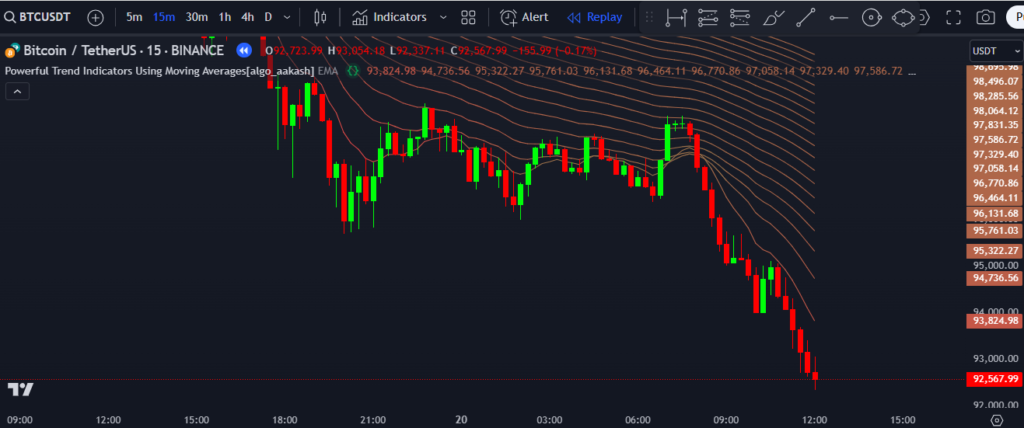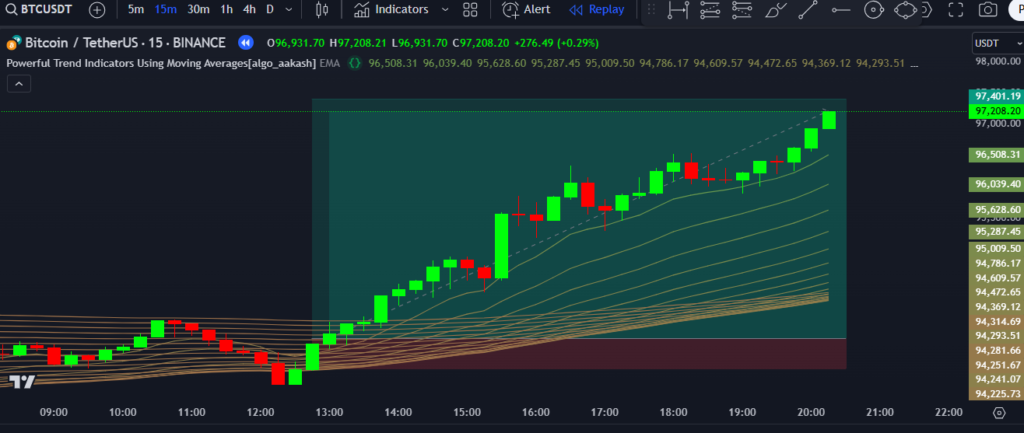🔓 Get All Tools for FREE!
- ✅ Click here to open a trading account using our referral link and start trading.
- 📅 After 7 days of active trading under our referral link, you can get access to all tools in your account.
- ⚠️ Keep trading to keep access free — if you're inactive for 7 days, your access will be removed.
- 👉 Already have an account? You can change the IB (introducing broker) to our referral link ( https://one.exnesstrack.org/a/w7syl3vnjb ) and still qualify!
What is the Powerful Trend Indicators Using Moving Averages Indicator?

In the world of trading, indicators play a crucial role in helping traders make informed decisions. Whether you’re trading stocks, forex, or cryptocurrencies, indicators can provide valuable insights into market trends, potential price movements, and overall market sentiment. In this article, we will explore one of the most powerful trend-following indicators available on TradingView – Moving Averages – and explain how they work, particularly when combined with Pine Script for customized trading strategies.
Explanation of the Indicator:
Moving Averages: The Backbone of Trend Indicators
🔓 Get All Tools for FREE!
- ✅ Click here to open a trading account using our referral link and start trading.
- 📅 After 7 days of active trading under our referral link, you can get access to all tools in your account.
- ⚠️ Keep trading to keep access free — if you're inactive for 7 days, your access will be removed.
- 👉 Already have an account? You can change the IB (introducing broker) to our referral link ( https://one.exnesstrack.org/a/w7syl3vnjb ) and still qualify!
A moving average (MA) is a commonly used technical indicator in trading. It is designed to smooth out price data over a specific period, helping traders identify the direction of the market trend more clearly. Moving averages are primarily used to filter out the market’s “noise” (short-term fluctuations) and highlight the underlying trend.
There are different types of moving averages, with the Simple Moving Average (SMA) and Exponential Moving Average (EMA) being the most popular. The SMA is calculated by averaging the closing prices over a certain period, while the EMA gives more weight to recent prices, making it more responsive to current market movements.
When combined with other technical tools, moving averages become a powerful trend-following indicator that can be used to signal buy or sell opportunities. Traders often use the crossovers between different types of moving averages (e.g., the 50-period moving average crossing above or below the 200-period moving average) to predict potential market shifts.
Indicator Overview: Powerful Trend Indicators Using Moving Averages
Moving averages are essential in identifying bullish and bearish trends. When the price of an asset is above a moving average, the market is generally considered to be in an uptrend, whereas when the price is below the moving average, the market is considered to be in a downtrend. By using multiple moving averages (such as a short-term moving average crossing above a long-term moving average), traders can confirm the strength and direction of the trend.
Additionally, moving averages can help traders determine the ideal entry and exit points. For instance, traders may buy when a short-term moving average crosses above a long-term moving average, signaling a potential upward trend. Conversely, they may sell when the short-term moving average crosses below the long-term moving average, signaling a potential downward trend.
How Does Powerful Trend Indicators Using Moving Averages Work on TradingView?

TradingView is one of the most popular charting platforms used by traders worldwide. It offers a wide range of tools and features for traders, including access to a variety of indicators, customizable charting options, and social features that allow traders to share their strategies and analysis.
TradingView and Moving Averages
On TradingView, setting up and using moving averages is straightforward. The platform allows traders to apply several moving averages to their charts with just a few clicks. Here’s how moving averages work on TradingView:
- Adding Moving Averages to Your Chart: To add a moving average to your TradingView chart, simply click on the “Indicators” button at the top of the chart screen. From the drop-down menu, search for “Moving Average” or “Exponential Moving Average” (EMA), depending on your preference. Once added, the moving average will appear directly on the price chart.
- Customizing the Moving Average: Once the moving average is applied to the chart, you can customize the period and style to suit your strategy. The period refers to the number of bars or candles used to calculate the moving average. For instance, a 50-period moving average would take the average closing price of the last 50 candles. Shorter periods (e.g., 9 or 21) are more sensitive and can help identify short-term trends, while longer periods (e.g., 200) are slower and more suitable for identifying long-term trends.
- Using Multiple Moving Averages: Many traders use multiple moving averages to create a more robust strategy. For example, you might use the 50-period SMA for the short-term trend and the 200-period SMA for the long-term trend. A Golden Cross occurs when a shorter moving average crosses above a longer one, indicating a potential uptrend. Conversely, a Death Cross occurs when the shorter moving average crosses below the longer one, indicating a potential downtrend.
- A 50-period simple moving average is plotted as the short-term moving average (green).
- A 200-period simple moving average is plotted as the long-term moving average (red).
- A buy signal occurs when the short-term MA crosses above the long-term MA (Golden Cross).
- A sell signal occurs when the short-term MA crosses below the long-term MA (Death Cross).
This script can be customized further based on your specific trading requirements, but it provides a foundation for utilizing moving averages to develop an automated trading strategy.
Why Use Moving Averages on TradingView?
- Clear Trend Identification: Moving averages are simple yet powerful tools for identifying market trends. Whether you are trading in a trending or sideways market, moving averages help smooth out price action and provide clarity.
- Customizable Strategies with Pine Script: With Pine Script, you can create personalized strategies tailored to your specific trading needs. By combining moving averages with other indicators or patterns, you can develop a more robust and refined strategy.
- Backtesting Capabilities: TradingView allows you to backtest your moving average strategies, helping you optimize your approach before applying it in live markets.
- Real-Time Alerts: Using Pine Script, you can set up real-time alerts for specific crossover events, ensuring you never miss a trading opportunity.
Conclusion
Incorporating moving averages into your trading strategy on TradingView can significantly enhance your decision-making process. With the ability to customize your indicators using Pine Script and leverage the platform’s powerful charting tools, traders can gain a better understanding of market trends and identify potential trading opportunities. Whether you’re a beginner or an experienced trader, mastering moving averages on TradingView can be a game-changer for your trading journey.
Pinescript of Powerful Trend Indicators Using Moving Averages

Reach out to us at +91 7620658346 to get access to this indicator. We specialize in custom algorithm development for TradingView, MT4/MT5, and trading bots.
Stay connected and updated by following @algo_aakash on Instagram, YouTube, and Twitter.
Disclaimer
The information provided in this article and any related indicators is for educational purposes only. Trading in financial markets involves significant risk, and there is no guarantee of profit.Powerful Trend Indicators Using Moving Averages, which may not predict future market behavior. Users should conduct their own research, assess their risk tolerance, and consult with a licensed financial advisor before making any trading decisions. The author and developer of this indicator are not responsible for any losses incurred through its use. Please trade responsibly.

0 Comments